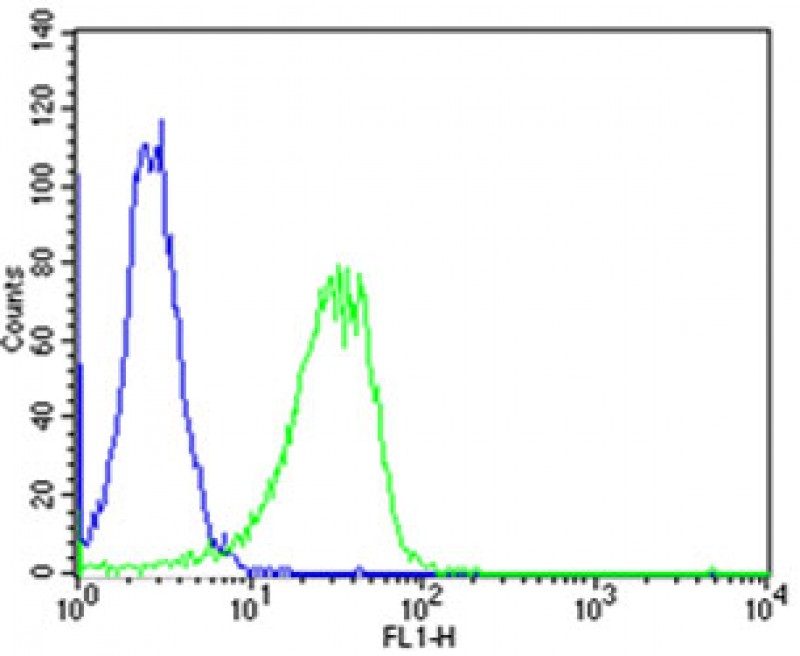(Mouse) Shh Antibody (C-term)
Purified Rabbit Polyclonal Antibody (Pab)
- SPECIFICATION
- CITATIONS
- PROTOCOLS
- BACKGROUND

Application
| FC, WB, E |
|---|---|
| Primary Accession | Q62226 |
| Reactivity | Mouse |
| Host | Rabbit |
| Clonality | Polyclonal |
| Isotype | Rabbit IgG |
| Calculated MW | 47773 Da |
| Gene ID | 20423 |
|---|---|
| Other Names | Sonic hedgehog protein, SHH, HHG-1, Sonic hedgehog protein N-product, Sonic hedgehog protein 19 kDa product, Sonic hedgehog protein C-product, Sonic hedgehog protein 27 kDa product, Shh, Hhg1 |
| Target/Specificity | This Mouse Shh antibody is generated from a rabbit immunized with a KLH conjugated synthetic peptide between 397-431 amino acids from the C-terminal region of mouse Shh. |
| Dilution | WB~~1:1000 FC~~1:25 |
| Format | Purified polyclonal antibody supplied in PBS with 0.09% (W/V) sodium azide. This antibody is purified through a protein A column, followed by peptide affinity purification. |
| Storage | Maintain refrigerated at 2-8°C for up to 2 weeks. For long term storage store at -20°C in small aliquots to prevent freeze-thaw cycles. |
| Precautions | (Mouse) Shh Antibody (C-term) is for research use only and not for use in diagnostic or therapeutic procedures. |
| Name | Shh {ECO:0000312|MGI:MGI:98297} |
|---|---|
| Synonyms | Hhg1 |
| Function | [Sonic hedgehog protein]: The C-terminal part of the sonic hedgehog protein precursor displays an autoproteolysis and a cholesterol transferase activity (PubMed:7736596, PubMed:7891723, PubMed:8824192). Both activities result in the cleavage of the full- length protein into two parts (ShhN and ShhC) followed by the covalent attachment of a cholesterol moiety to the C-terminal of the newly generated ShhN (PubMed:8824192). Both activities occur in the reticulum endoplasmic (PubMed:21357747). Once cleaved, ShhC is degraded in the endoplasmic reticulum (PubMed:21357747). |
| Cellular Location | [Sonic hedgehog protein]: Endoplasmic reticulum membrane {ECO:0000250|UniProtKB:Q15465}. Golgi apparatus membrane {ECO:0000250|UniProtKB:Q15465}. Note=Co-localizes with HHAT in the ER and Golgi membrane. {ECO:0000250|UniProtKB:Q15465} |
| Tissue Location | Expressed in a number of embryonic tissues including the notochord, ventral neural tube, floor plate, lung bud, zone of polarizing activity and posterior distal mesenchyme of limbs In the adult, expressed in lung and neural retina |
If you have used an Abcepta product and would like to share how it has performed, please click on the "Submit Review" button and provide the requested information. Our staff will examine and post your review and contact you if needed.
If you have any additional inquiries please email technical services at tech@abcepta.com.














 Foundational characteristics of cancer include proliferation, angiogenesis, migration, evasion of apoptosis, and cellular immortality. Find key markers for these cellular processes and antibodies to detect them.
Foundational characteristics of cancer include proliferation, angiogenesis, migration, evasion of apoptosis, and cellular immortality. Find key markers for these cellular processes and antibodies to detect them. The SUMOplot™ Analysis Program predicts and scores sumoylation sites in your protein. SUMOylation is a post-translational modification involved in various cellular processes, such as nuclear-cytosolic transport, transcriptional regulation, apoptosis, protein stability, response to stress, and progression through the cell cycle.
The SUMOplot™ Analysis Program predicts and scores sumoylation sites in your protein. SUMOylation is a post-translational modification involved in various cellular processes, such as nuclear-cytosolic transport, transcriptional regulation, apoptosis, protein stability, response to stress, and progression through the cell cycle. The Autophagy Receptor Motif Plotter predicts and scores autophagy receptor binding sites in your protein. Identifying proteins connected to this pathway is critical to understanding the role of autophagy in physiological as well as pathological processes such as development, differentiation, neurodegenerative diseases, stress, infection, and cancer.
The Autophagy Receptor Motif Plotter predicts and scores autophagy receptor binding sites in your protein. Identifying proteins connected to this pathway is critical to understanding the role of autophagy in physiological as well as pathological processes such as development, differentiation, neurodegenerative diseases, stress, infection, and cancer.



